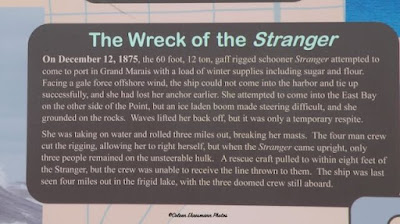There were three reasons for the MN road trip to include a drive along the North Shore of Lake Superior: geocaching, revisit the road trip we took August 1970, and for me to see and photograph lighthouses.
Our first lighthouse stop was the Two Harbors Light Station. The story behind this National Register of Historic Places started in 1884 when iron ore was mined in the Vermillion Range and being shipped from Two Harbors. At the time the Two Harbors port far surpassed Duluth is shipping importance. Commercial fishing and the mining water traffic increased making the natural labor port extremely dangerous. Many ships went aground or were dashed to bits along the foggy shoreline of Lake Superior. Most of the disasters were eliminated when the Two Harbors Light Station was completed in 1892.
The original light station was lit with kerosene. To help protect the light station keeper who lived in the two story main house, the walls were constructed two bricks thick. The light house walls were constructed three bricks thick. The wall between the tower and the main house is five bricks thick giving added protection should the kerosene ever explode.
The buildings are now a museum, a bed and breakfast and gift shop, none of which was open. There is a second lighthouse at Two Harbors we did not see.
This is where the iron ore is loaded onto ships.
From the Lake County Chamber of Commerce web page:
One of the most awe-inspiring things do in Two Harbors is to watch the ore boats in Agate Bay. Many of these vessels are over 1,000 feet long and it’s amazing to witness them maneuver in and out of our small port with ease. Stood upright from end to end, the biggest ships that we see in our port would stand almost as tall as the Chrysler Building! A popular spot to watch them is from the end of the breakwall, where they come so close that it feels like you can reach out and touch them!
You will mostly see ‘lakers’ (ships that travel within the Great Lakes) in Agate Bay, with the occasional ‘salty’ (ocean going vessel). Ships arrive in Two Harbors to load with iron ore, which is the primary ingredient for making steel. The ore is delivered to port by rail from mines in northern Minnesota; the vessels load up and transport the ore to steel mills, such as in Northwest Indiana, Detroit, Cleveland, and Ontario.
two tug boats waiting for some action
at first I thought this was a tug boat,
but maybe it is a commercial fishing vessel
There was no action in the Two Harbors bay while we were there. In fact, we did not see any ships on our drive.
Our next stop was NOT a lighthouse, but a pleasant and unexpected location. I had heard of Gooseberry Falls. We drove past the sign for the state park, but did not have time to check it out, he said. BUT, Lo and Behold, a geocache was right along the highway with safe pull-off parking. I could hear the water rushing over the falls. I could see the rapid flowing Gooseberry River. Notice the color of the water!
There was a trail and boardwalk from the bridge heading down, so I followed it. (I knew he would not leave without me!) What a dramatic sight and sound! This area had a recent major snow storm and the rivers and lakes are recently experiencing their ice-off giving volume to the river as it empties into Lake Superior.
I believe the first photo is of the Middle Falls. The water then divides creating two Lower Falls. According to the State Park information, the falls are more of a trickle in the summer months. I am thrilled we got to see it during melting season.
Split Rock Lighthouse
This is probably the most well known North Shore Lighthouse. It was on my 'we-will-stop-and-see' locations on this part of the road trip. We heard on the local news on Monday night the visitor center at the park suffered a major electrical outage when a lightning "strike hit a tree in our parking lot and connected with a light pole and the current traveled back to the visitor center affecting some of our systems internally." The visitor center was closed, so we stopped at a scenic view pull-off along the highway to get this photo.
The Split Rock Lighthouse sits atop a 160 foot cliff. Split Rock Lighthouse was completed in 1910, in the wake of a storm five years earlier that resulted in numerous shipwrecks across the Great Lakes — including several along the North Shore.
Our final light house stop was in Grand Marais. According to Wikipedia The tower was first lit in 1922 and is still operational.
The original keeper's house on shore is now operated as the main museum of the Cook County Historical Society. The museum features exhibits on area history, industry and culture.
I am standing at the halfway point on the walk to the lighthouse. I took a photo of three women and a dog walking along the breakwater and the natural harbor geologic formations. In other words, rocks. This is what we walked on and would have continued on if we had walked out to the lighthouse. We got as far as the geocache location. I got my photos. I was happy to head back as it was windy and cold.
click on the photos (or any photo) to get a larger version
the stories of how the lighthouse came to be
There were several lighthouses in Duluth we did not see. I am happy with what we did see. A successful road trip!





.jpeg)






No comments:
Post a Comment
Thanks for your comments!